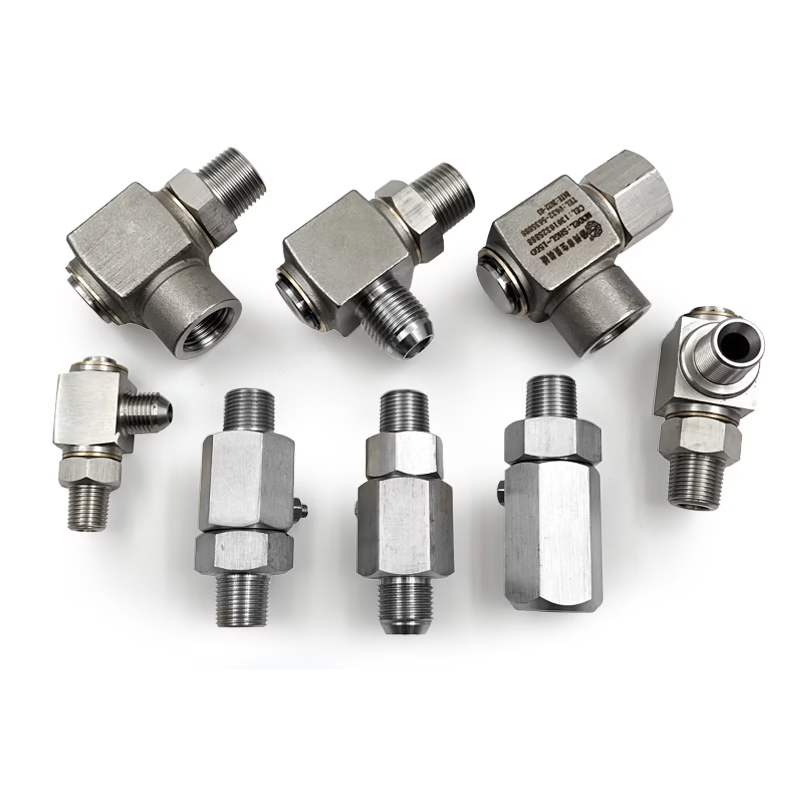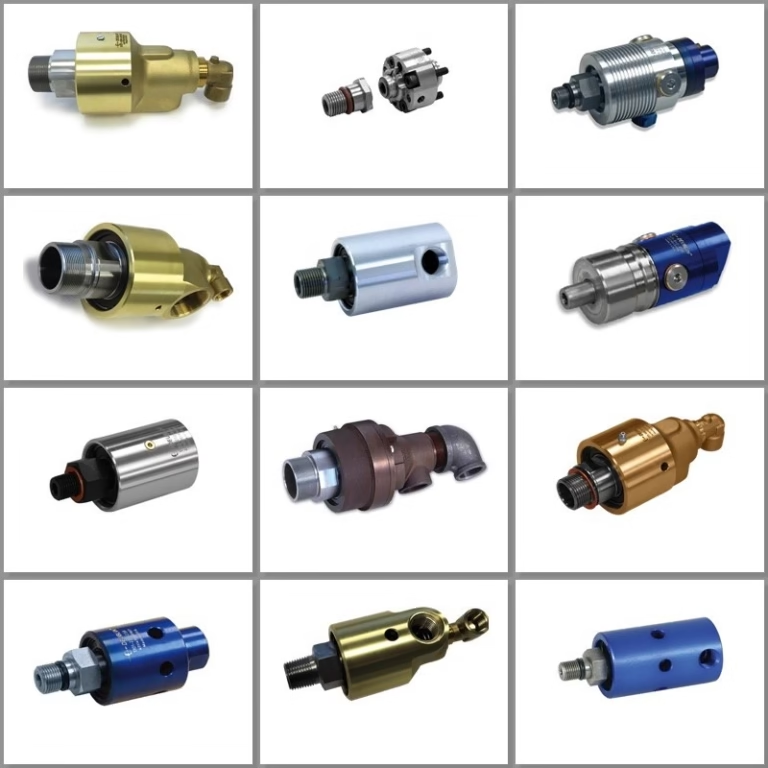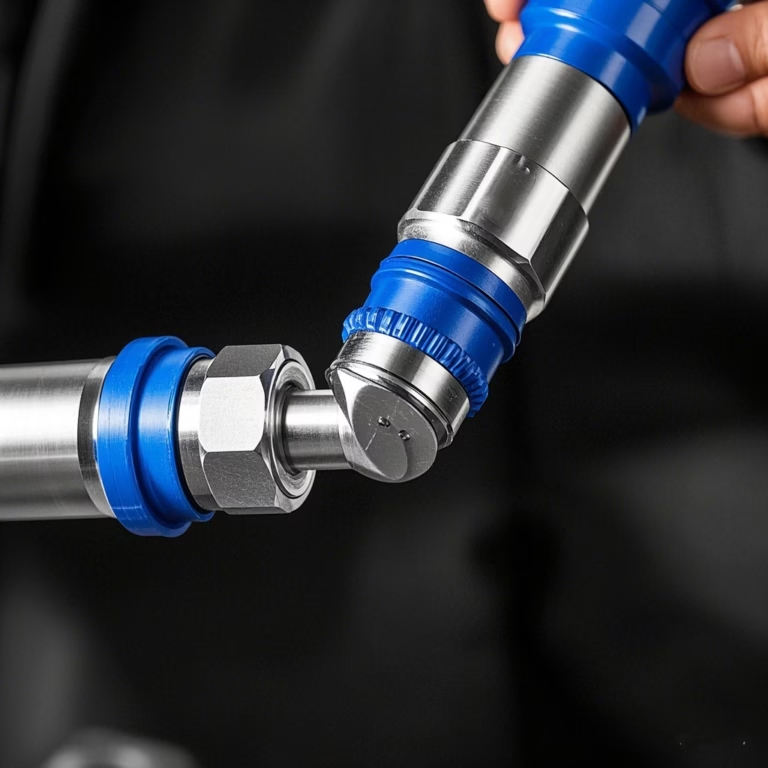What Is a Rotary Joint Hydraulic? A Complete Guide for Engineers
In the dynamic world of fluid power systems, rotary joint hydraulic plays a crucial yet often under-explored role. As industries continue to evolve, the demand for efficient and reliable fluid transfer solutions has never been higher.
Rotary joint Hydraulic, also known as hydraulic swivel joints, emerge as key components that enable seamless fluid transfer between stationary and rotating parts of machinery. This blog post will delve deep into what hydraulic hose rotary joints are, their components, working principles, types, applications, maintenance, and future trends.
Definition and Basic Concept
A rotary joint hydraulic is a mechanical device specifically engineered to facilitate the transfer of hydraulic fluid between a stationary source and a rotating component in a hydraulic system. Its primary function is to maintain a continuous, leak-proof connection, allowing the hydraulic fluid to flow smoothly even as the connected equipment rotates. This enables machinery to perform complex rotational movements while ensuring the hydraulic system operates efficiently.
At the heart of any hydraulic system is the need to transmit power through fluid. Hydraulic rotary joints make it possible for this power transmission to occur without interruption, even when parts of the system are in motion. They are essential in applications where rotating machinery, such as hydraulic presses, construction equipment, and industrial robots, rely on hydraulic power. Without these joints, the transfer of hydraulic fluid would be disrupted, leading to inefficiencies and potential breakdowns in the machinery.
Components of a rotary joint hydraulic
Housing
The housing is the outer shell, offering structural support and safeguarding internal parts. Manufacturers build it from high-strength materials like stainless steel, carbon steel, or alloy steel, based on application needs such as pressure, temperature, and environment. In high-pressure uses, thick-walled carbon steel housing resists hydraulic fluid forces. It has inlet and outlet ports for hoses, with threaded or flanged interfaces for secure, leak-proof connections. Mounting flanges may also aid installation.
Rotor
The rotor, the rotating part, links to the moving equipment and spins inside the housing. Engineered from durable materials, it endures rotation and fluid pressure. Its internal channels guide hydraulic fluid, aligning with housing ports as it rotates. Smooth, well-designed channels reduce fluid resistance, optimizing system performance.
Seals
Seals are crucial, preventing fluid leakage between the housing and rotor. Types like mechanical, lip, and OO-ring each have their uses. Mechanical seals with mating surfaces handle high pressures and temps. Lip seals block leakage on the shaft, and O – O-rings work in low-pressure setups or with other seals. Seal choice depends on fluid type, pressure, temperature, and speed.
Bearings
Bearings support rotor rotation, cutting friction, and wear for smooth joint operation. Ball, roller, and sleeve bearings are common. Ball bearings suit high speeds due to low friction, roller bearings handle heavy loads, and sleeve bearings are simple and cost-effective. The right bearing choice, based on speed, load, and precision, extends joint life.
End Caps
End caps close the housing ends, protecting components and securing the rotor. Made of the same housing material, they bolt or thread on tightly. Some have features for seal and bearing installation. Removable end caps ease maintenance, enabling cleaning, repair, and part replacement.
Working Principle
The working principle of a hydraulic hose rotary joint is based on the separation of the stationary and rotating elements of a hydraulic system while maintaining fluid flow. When the joint is installed, the stationary housing connects to the hydraulic fluid source, such as a pump, through the inlet port. The hydraulic fluid then enters the housing and flows into the internal channels of the rotor.
As the equipment connected to the rotor starts to rotate, the rotor spins within the housing. The seals between the rotor and the housing prevent the fluid from leaking out, maintaining the integrity of the hydraulic system. The bearings support the rotation of the rotor, allowing it to turn smoothly with minimal friction.
The hydraulic fluid travels through the internal channels of the rotor and exits through the outlet port, which connects to the rotating part of the machinery. This continuous flow of hydraulic fluid enables the rotating equipment to receive the necessary power to perform its functions. Whether it’s the rotation of a hydraulic-powered turntable or the movement of a robotic arm, the hydraulic hose rotary joint ensures that the hydraulic fluid reaches the right place at the right time.
In high-pressure applications, the design of the hydraulic hose rotary joint becomes even more critical. The seals and other components must be able to withstand the intense pressure to prevent leakage. Additionally, the joint’s ability to handle high-speed rotations without compromising fluid flow is essential for the efficient operation of the machinery.
Types of rotary joint hydraulic
Single-Passage Hydraulic Rotary Joints
Single-passage hydraulic hose rotary joints are the simplest type. They allow for the transfer of a single hydraulic fluid in one direction. These joints have a single inlet and a single outlet port, making them suitable for applications where only one type of hydraulic fluid needs to be transferred.
For example, in a basic hydraulic-powered conveyor system, a single-passage joint can be used to transfer hydraulic fluid from a stationary pump to a rotating drum. Their straightforward design makes them cost-effective and easy to install and maintain. However, they are limited in their functionality compared to multi-passage joints.
Multi-Passage Hydraulic Rotary Joints
Multi-passage hydraulic hose rotary joints are designed to handle the transfer of multiple hydraulic fluids simultaneously. They have multiple inlet and outlet ports, each dedicated to a different fluid. This makes them ideal for complex hydraulic systems where different fluids, such as hydraulic oil, coolant, or lubricant, need to be transferred to a rotating component.
In industrial robots, for instance, multi-pass joints can be used to supply hydraulic fluid for movement, coolant for temperature control, and lubricant for reducing friction in different parts of the robot. These joints require more precise engineering to ensure that each fluid is transferred without interference and that there is no cross-contamination between the different fluid channels.
High-pressure Hydraulic Rotary Joints
High-pressure hydraulic hose rotary joints are engineered to withstand pressures significantly higher than normal operating levels. They are used in applications such as hydraulic presses, high-pressure water jetting systems, and oil and gas exploration equipment.
The construction of high-pressure joints involves using stronger materials, thicker walls, and more robust seals. For example, the housing may be made of high-strength alloy steel, and the seals may be designed with special materials and configurations to handle the intense pressure. These joints also often feature advanced bearing designs to support the rotor under high-pressure conditions and ensure smooth rotation.
High-Speed Hydraulic Rotary Joints
High-speed hydraulic hose rotary joints are designed to operate at high rotational speeds, typically more than 10,000 RPM. They are commonly used in applications such as high-speed centrifuges, certain types of industrial machinery, and some aerospace components.
To function effectively at high speeds, these joints require low-friction bearings and high-performance seals. Ball bearings with low-drag designs are often used to minimize friction and heat generation. The seals are engineered to maintain a tight seal even at high speeds, preventing fluid leakage and ensuring the joint’s reliability. Additionally, the rotor and housing may be balanced to reduce vibrations, which can occur at high rotational speeds and affect the performance of the joint and the connected machinery.
Applications of Hydraulic Rotary Joints
Construction Equipment
In construction, hydraulic hose rotary joints are vital. Excavators use them to send hydraulic fluid to the turret, enabling arm and bucket movements for digging, lifting, and loading. Bulldozers rely on these joints to power hydraulic systems, controlling the blade, and ensuring smooth fluid flow during operation. Crane trucks use them for crane boom rotation, crucial for moving heavy loads; without them, crane efficiency drops significantly.
Industrial Manufacturing
In manufacturing plants, these joints are used widely. Hydraulic presses depend on them to transfer fluid to moving parts, helping exert force for metal shaping. Industrial robots incorporate them for precise and flexible movement, as hydraulic fluid powers their joints and actuators. Conveyor systems may use them to drive roller rotation, ensuring continuous material flow and higher efficiency.
Aerospace Industry
In aerospace, they are essential. Landing gear systems use these joints for fluid transfer during extension and retraction, withstanding high pressure and extreme flight conditions. Flight control systems rely on them to ensure fluid reaches components for precise flight path control. They’re also used in aircraft engines for lubrication and cooling, requiring high reliability for engine safety.
Oil and Gas Industry
In this industry, they have multiple uses. Drilling rigs transfer fluid to drill bits, powering rotation, and mud pumping for bit cooling and wellbore stability. Fracking operations use high-pressure joints to transfer fracturing fluids, withstanding harsh conditions. In refineries and plants, they transfer fluid to power and control pumps and compressors.
Maintenance of Hydraulic Rotary Joints
Regular Inspection
Regular inspection is essential for the proper maintenance of hydraulic hose rotary joints. Inspect the joint for signs of leakage, which can indicate a problem with the seals. Look for any fluid stains or drips around the joint, especially at the inlet and outlet ports.
Check the housing for any cracks, dents, or other signs of damage that could affect its structural integrity. Examine the rotor for wear or damage, paying attention to the internal channels and the surface that contacts the seals. Also, inspect the bearings for any signs of wear, such as excessive play or abnormal noise.
Lubrication
Proper lubrication of the bearings is crucial for the smooth operation of hydraulic hose rotary joints. Follow the manufacturer’s recommendations regarding the type and frequency of lubrication. Use high-quality lubricants that are suitable for the operating conditions of the joint, such as the temperature and load.
Lubrication helps to reduce friction between the moving parts, preventing wear and extending the lifespan of the bearings. It also helps to dissipate heat generated during operation, ensuring that the joint operates within the recommended temperature range.
Cleaning
Keep the exterior of the hydraulic hose rotary joint clean to prevent the accumulation of dirt, debris, and contaminants. Use appropriate cleaning agents and methods to clean the joint without damaging the components.
In some cases, the internal components may also need to be cleaned periodically, especially if the hydraulic fluid contains particulates. This can be done by flushing the joint with a clean, compatible fluid according to the manufacturer’s instructions. Cleaning helps to maintain the efficiency of the joint and prevents the buildup of substances that could cause blockages or damage to the seals and other components.
Replacement of Worn-Out Components
If any components, such as seals, bearings, or the rotor, are found to be worn out or damaged, replace them immediately. Using worn-out components can lead to leakage, increased friction, and reduced performance of the hydraulic hose rotary joint.
Keep spare parts on hand to minimize downtime in case of component failure. When replacing components, ensure that they are of the correct type and规格, and follow the manufacturer’s installation instructions carefully to ensure proper assembly and operation of the joint.
Future Trends of Hydraulic Rotary Joints
Advancements in Materials
The future of hydraulic rotary joints will likely see significant advancements in materials. New materials with improved properties, such as higher strength, better corrosion resistance, and enhanced thermal stability, are being developed.
For example, the use of advanced composites in the construction of the housing and rotor could reduce the weight of the joint while maintaining or even increasing its strength. These materials could also offer better resistance to harsh environmental conditions, making the joints more suitable for use in challenging applications.
In addition, the development of new seal materials with improved sealing performance, longer lifespan, and better compatibility with different hydraulic fluids is expected. This will help to further reduce leakage and improve the overall reliability of the joints.
Integration of Smart Technology
The integration of smart technology into hydraulic rotary joints is another emerging trend. Smart joints could be equipped with sensors that monitor parameters such as pressure, temperature, vibration, and fluid flow.
This real-time monitoring would allow for predictive maintenance, enabling operators to detect potential problems before they occur and take proactive measures to prevent downtime. The data collected from the sensors could also be analyzed to optimize the performance of the joint and the entire hydraulic system.
For example, if the sensor detects an abnormal increase in temperature or vibration, it could alert the operator, who can then investigate and address the issue before it leads to a breakdown. Smart technology could also enable remote monitoring and control of the joints, increasing operational efficiency and reducing the need for on-site inspections.
Miniaturization
As industries, especially those in the electronics and medical fields, continue to demand smaller and more compact components, the miniaturization of hydraulic rotary joints is likely to become a significant trend.
Miniature hydraulic rotary joints would meet the specific requirements of these industries. Such as low-space installation, precise fluid transfer, and high-performance applications. Achieving miniaturization would require advanced manufacturing techniques and innovative designs. To ensure that the joints can still perform their functions effectively despite their smaller size.
Conclusion
In conclusion, hydraulic rotary joints are indispensable components in a wide range of industries. Their ability to enable the transfer of hydraulic fluid between stationary and rotating parts of machinery is crucial for the efficient operation of numerous types of equipment.
Understanding their components, working principles, types, applications, maintenance, and future trends is essential for engineers, technicians, and industry professionals who rely on hydraulic systems. As technology continues to evolve, hydraulic rotary joints will undoubtedly become even more advanced, reliable, and efficient, further enhancing the performance of industrial machinery and processes.







